Ever-changing Moods in the Garden
As changeable as the weather has been in 2021, the planting in the South Garden has also changed beyond recognition from its colourful and explosive start to its mellow and melancholic finale.
Winter in the South Garden is quiet. The spherical box balls, leafless structure of the conical silver pears and the intricate woven hazel and willow plant supports provide the main interest at this time. But as the spring progresses and the days get longer an atmosphere of excitement and anticipation is in the air. In between the lush green growth of the herbaceous perennials are 4000 tulips, ready to burst into a spectacular explosion of colour. Winter has ended, bring on the summer!
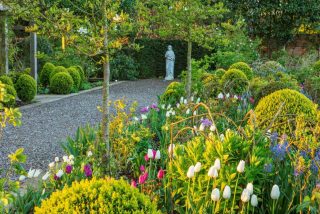
The tulip varieties are chosen to bloom together in early May to give an impactful display in shades of pink, purple, white and blue. They are woven through the borders in intricate repeated patterns to give scale and perspective. As the tulips fade, they are replaced by the purple spheres of Allium ‘Purple Sensation’ and A. cristophii. These bulbous plants are joined by bearded Iris germanica cultivars such as the pure white ‘Snowy Owl’, light pink ‘Crispette’, dark blue ‘Deep Pacific’ and deep red ‘Rio Rojo’. Herbaceous peonies are also flowering at this time such as Paeonia ‘Krinkled White’ and together with the Iris and Allium create strong and bold, architectural shapes in the borders. During the autumn months we are very busy lifting and dividing the herbaceous perennials so that everything has its place, so in the late spring the planting is still quite contained; formal and rigid. Nothing is left to chance.
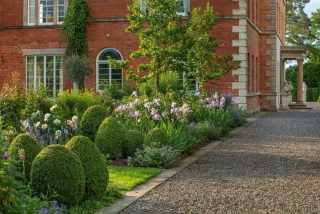
Even in June, which is known for romantic rose displays, there is still a sense of order and structure in the borders. Rose bushes are clad in sumptuous blooms but still distinct entities, in close proximity to, but sill separate from their herbaceous neighbours. This is the month of tall herbaceous perennials, such as Campanula lactiflora, Veronicastrum, Delphinium and early flowering Aconitum ‘Silver Sails’.
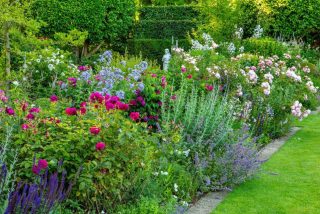
Earlier in the spring, we have prepared for the mid and late summer phase of the garden drama: From mid-March to mid-May we have been tying in Clematis into woven willow and hazel plant supports. Each Clematis is planted in the centre of a group of three roses. As the Clematis grows rapidly in spring, it is important that we tie the Clematis into the support to keep it off the rose and allow the rose to grow up through the plant support and flower in June. It is only when the rose is above the height of the plant support and about to flower that we allow the Clematis to run into the centre of the rose. This is because as the first flush of rose flowers fade in July, they are replaced by the flowers of the Clematis that take over the colour for July as the roses take a well-earned rest.
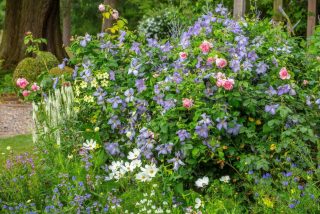
Also, in late spring we remove the tulips and replace them with 450 summer flowering annuals grown from seed in our greenhouses each year. The tulips have done their job and now attention turns to adding extra colour to fill out the borders later in the summer. Spires of pink and white Cleome spinosa stand out between tall herbaceous perennials of Aconitum, Campanula and Phlox. Further forward in the border the zingy Nicotiana alata ‘Lime Green’ breaths freshness into the pastel colours. Soft pink and white Cosmos sonata and robust Zinnia ‘Giant Purple Prince’ are grown amongst Echinacea and Agapanthus. Finally blue and white Echium vulgare spill out over the front of the border softening the sharp edges of the paving.
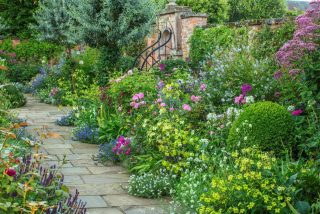
As the herbaceous perennials have grown up and reach their final height, the Clematis bloom and knit together with the roses, and the summer flowering annuals fill out the borders the South Garden takes on a softer and more mellow atmosphere in late summer As the days get shorter and the light changes the colours in the borders start to sing and the picture is complete. It is the South Garden’s final swan song for the year as come October the cycle begins again as we begin cutting back the borders, lifting and dividing the perennials, planting tulips, and building Clematis and rose supports. But for now, we can enjoy the triumphant last colour of summer in the South Garden.
